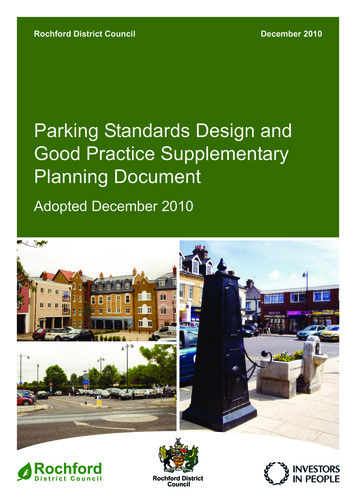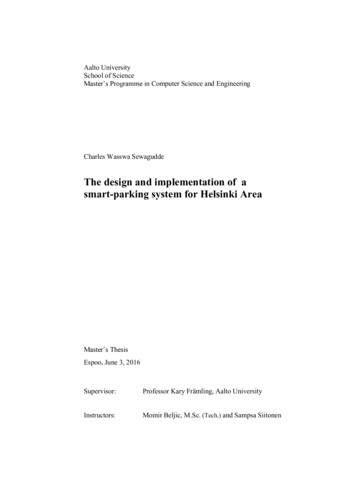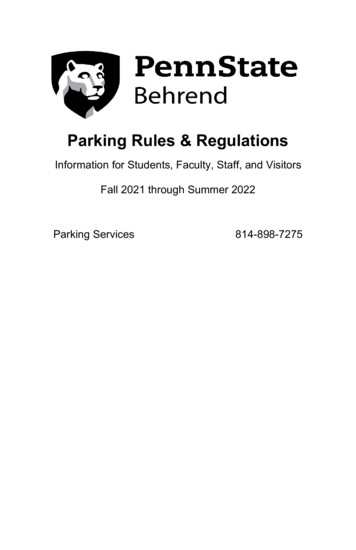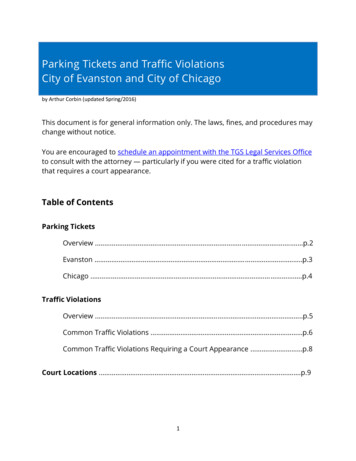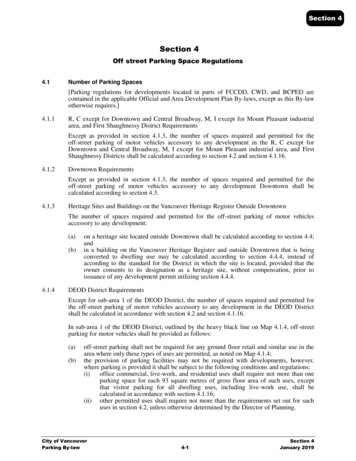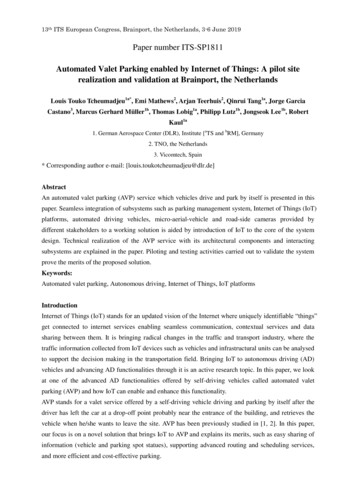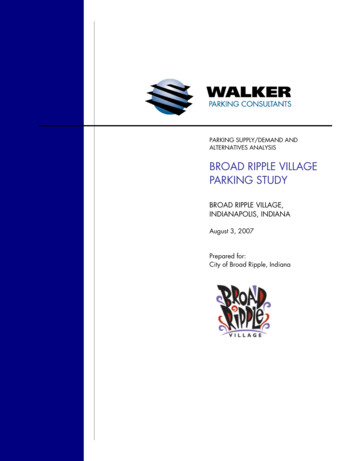
Transcription
PARKING SUPPLY/DEMAND ANDALTERNATIVES ANALYSISBROAD RIPPLE VILLAGEPARKING STUDYBROAD RIPPLE VILLAGE,INDIANAPOLIS, INDIANAAugust 3, 2007Prepared for:City of Broad Ripple, Indiana
Walker Parking Consultants6602 East 75th Street, Suite 210Indianapolis, IN 46250Voice: ugust 3, 2007Ms. Barbara LawrenceIndianapolis Local Public Improvement Bond Bank2342 City-County Building200 East Washington StreetIndianapolis, IN 46204Dear Ms. Lawrence:Re:Parking Supply/Demand, Alternatives, and On-Street AnalysisBroad Ripple VillageWalker Project #13-2847.00Walker Parking Consultants is pleased to provide the following parking analysis for Broad RippleVillage. This report documents our findings and recommendations regarding current and futureparking conditions.We appreciate this opportunity to be of service to you, the City of Indianapolis, and Broad RippleVillage. We look forward to discussing our report with the appropriate representatives in thenear future.Sincerely,WALKER PARKING CONSULTANTSJon R. Martens, CPPParking ConsultantEnclosure
PARKING SUPPLY/DEMANDAND ALTERNATIVES ANALYSISBROAD RIPPLEVILLAGEPARKING STUDYBROAD RIPPLE, INDIANAPrepared for:BROAD RIPPLE VILLAGE,INDIANAPOLIS, INDIANAPROJECT NO.13-2847.00AUGUST 3, 2007
BROAD RIPPLE VILLAGEPARKING SUPPLY/DEMAND AND ALTERNATIVES ANALYSISAUGUST 3, 2007EXECUTIVE SUMMARY . iiINTRODUCTION . 1Objectives. 1Study Area . 1Definition of Terms . 3Scope of Services . 4Task 1- Supply Demand Analysis. 4Task 2- Alternatives Analysis. 5Task 3- Report Preparation . 6Study Methodology . 6EXISTING PARKING CONDITIONS . 8Current Supply . 8Effective Parking Supply . 9Parking Demand . 11Peak Occupancy by Zone . 17Parking Adequacy . 18Conclusions . 19FUTURE PARKING CONDITIONS . 20Parking Demand . 20Changes to Parking Supply . 22Future Parking Adequacy . 22Conclusions . 23Sub-Area Parking Adequacy . 26Walking Distance and Parking Adequacy . 26ALTERNATIVES ANALYSIS . 24Increasing the Parking Supply. 24Walking Distance and Parking Adequacy. 24Minimum Parking Structure Dimensions . 25Potential Sites for Adding Parking . 26Site Descriptions . 28Increasing Cost of Parking Structures . 30Opinion of Cost . 33Operating Costs . 34Break-Even Point . 35Wayfinding/Signage . 37Lighting . 38Regulating Employee Parking . 39Exploring Opportunities for Valet Parking . 39Residential Parking Program . 40Circulator Shuttle Option . 40Summary. 41TABLE OF CONTENTSLIST OF TABLES AND FIGURESTable 1: Adequacy Flow Chart7Table 2: Distribution of ParkingSupply8Table 3: Effective Supply Ratios9Table 4: Weekday Pkg Inventory andEffective Pkg Supply10Table 5: Weekend Parking Inventoryand Effective ParkingSupply10Table 6: Observed Weekday PeakHour (12:00PM)Occupancy by Block13Table 7: Observed Weekend PeakHour (11:00PM)Occupancy by Block14Table 8: Zone Occupancy –Weekend 11:00 p.m.17Table 9: Zone Occupancy – PeakWeekday17Table 10: Summary of CurrentParking Adequacy18Table 11: Parking Adequacy byZone19Table 12: Potential Developments 20Table 13: Future DevelopmentDemand – Weekdayaround Noon21Table 14: Future Development DemandWeekend22Table 15: Future Parking Adequacy –Weekday23Table 16: Future Parking Adequacy –Weekend23Table 17: Walking Distance Level ofService Conditions25Table 18: Minimum Parking StructureDimensions26Table 19: Parking StructureOpinion of Cost33Table 20: Opinion of Cost includingSoft Costs34Table 21: Median per SpaceOperating Expenses35Table 22: Annual Breakeven Costper Structured ParkingSpace36Table 23: Level of Service LuminanceRatings38i
BROAD RIPPLE VILLAGEPARKING SUPPLY/DEMAND AND ALTERNATIVES ANALYSISAUGUST 3, 2007LIST OF TABLES AND FIGURESAPPENDIX A – Scope of ServicesAPPENDIX B – Parking Supply and Occupancy DataAPPENDIX C – Parking Adequacy by BlockAPPENDIX D -- Residential Parking Permit ProgramsFigure 1: Broad Ripple Study AreaFigure 2: Broad Ripple WeekdayOccupancy LevelsFigure 3: Broad Ripple WeedendOccupancy LevelsFigure 4: Weekday ParkingOccupancy (12:00 p.m.)Figure 5: Weekend ParkingOccupancy (11:00 p.m.)Figure 6: Potential Parking SitesFigure 7: Site AFigure 8: Site BFigure 9: Site B Service AreaFigure 10: Construction Costs AboveGrade ParkingFigure 11: Construction Costs BelowGrade ParkingFigure 12: Potential Shuttle Route21112151627282930313241ii
BROAD RIPPLE VILLAGEPARKING SUPPLY/DEMAND AND ALTERNATIVES ANALYSISAUGUST 3, 2007Broad Ripple Village (“Broad Ripple”) experiences high levels ofparking occupancy during peak weekend activity. Current parkingadequacy is short by about 130 spaces in the core area, and weanticipate the shortage to grow to 180 spaces within five years,assuming development of known projects is completed as outlined inour full report.EXECUTIVE SUMMARYPeak parking demand was observed to occur during a weekendaround 11:00 p.m. Of 40 blocks in the study area, 16 blocks hadparking occupancy levels at or above 85 percent, which representsthe maximum occupancy level before parking deteriorates toproblematic conditions.Observations were done on a typicalweekend and during an event period, when parking demand wouldlikely be even higher. Weekday parking is adequate, although oneblock experienced parking above what would be considered theoptimal level.We recommend the following actions for improving the existing supply: Consider increasing the parking supply through either aparking structure, surface lot, or circulator shuttle;Improve wayfinding signage to direct parkers to off-streetparking areas;Consider extending the hours for meter collections andenforcement to capture additional revenue that could be usedto pay for improvements to Broad Ripple parking;Once the parking supply is increased, determine if localresidents want to establish residential parking permit programs;Establish and encourage employees to park in designatedemployee parking areas away from the customer demand;Encourage valet parking to move some of the parking demandto available parking areas;Ensure that future developments have a parking plan, toinclude supplying sufficient parking spaces that are available totheir specific user as well as the general public; and,Improve lighting for existing on and off street parking areas.ii
BROAD RIPPLE VILLAGEPARKING SUPPLY/DEMAND AND ALTERNATIVES ANALYSISAUGUST 3, 2007Broad Ripple Village is a unique destination located withinIndianapolis, Indiana. The area is known for its diverse street life,including unique boutiques, restaurants, hair salons, and an activenightlife. The success of the area has created growing concern andinterest in providing adequate parking. In order to quantify andunderstand the magnitude of the parking issues, the City ofIndianapolis retained Walker Parking Consultants (“Walker”) toprovide a parking supply/demand and alternatives analysis for BroadRipple.INTRODUCTIONOBJECTIVESThis report quantifies the current parking conditions in Broad Ripple,considers the impact of changes to parking conditions from potentialdevelopments, and provides alternatives to show what can be done toimprove parking conditions.STUDY AREAthThe study area consists of 40 city blocks, bound by 67 Street to thestnorth, Compton Street and the White River to the east, 61 Street to thesouth, and Broadway Street to the west. The area was further dividedinto five zones, A, B, C, D and E, based on both geographicallocation and land use to aid in analyzing the data.Key terrain features in the study area include the Central Canal, whichruns east/west, and generally divides the study area into a northernand southern section, and the Monon Trail, which runs north south onthe east end of the study area. Generally speaking, the area consistsof a core business/entertainment area, surrounded by residentialareas.Figure 1 provides an overview of the study area, assigned blocknumbers, and zone identification for this analysis.1
BROAD RIPPLE VILLAGEPARKING SUPPLY/DEMAND AND ALTERNATIVES ANALYSISAUGUST 3, 2007Figure 1: Broad Ripple Study AreaThe corebusiness areasinclude zonesC and D.Zones A and Eare primarilyresidential andzone B is a mixof business andresidential landuses.2
BROAD RIPPLE VILLAGEPARKING SUPPLY/DEMAND AND ALTERNATIVES ANALYSISAUGUST 3, 2007DEFINITION OF TERMSSeveral terms used in this report have unique meanings when used inthe parking industry. To help clarify these terms and enhanceunderstanding by the reader, definitions for some of these terms arepresented below.¾ Demand Generator – Any building, structure, business, orattraction that brings individuals into the study area, therebyincreasing parking demand and occupancy.¾ Effective Supply – The total supply of parking spaces adjustedto reflect the cushion needed to allow patrons to spend lesstime looking for the last few available spaces in the parkingfacility and to account for the dynamics of vehicles moving inand out of spaces. It also accounts for spaces unavailable dueto maintenance, improper parking, and snow removal. Theeffective supply varies by user group and type of parking, buttypically the effective supply is 85 percent to 95 percent of thetotal number of spaces. The adjustment factor is known as theEffective Supply Factor.¾ Inventory – The total number of parking spaces counted duringsurvey day observations within the study area.¾ Occupancy – The number of parked vehicles observed on asurvey day.¾ Parking Adequacy – The difference between the effectiveparking space supply and parking demand.¾ Parking Demand – The number of spaces required to satisfyvisitor, employee, and resident needs on a given day.¾ Survey Day – The days that the parking occupancy countswere conducted in Broad Ripple.3
BROAD RIPPLE VILLAGEPARKING SUPPLY/DEMAND AND ALTERNATIVES ANALYSISAUGUST 3, 2007SCOPE OF SERVICESThe following scope of services for this study was proposed andaccepted:TASK I – SUPPLY DEMAND ANALYSIS1.Meet with representatives of the City and or Broad Ripple Villageto further clarify study’s objectives, review the work plan, andfinalize the project schedule. At this meeting, the lines ofcommunication and a schedule of deliverables will also beestablished.2.Obtain the following information from the City or Broad RippleVillage representatives: Building occupancy – the occupancy of major buildings andthe City’s best estimate for other buildings. Future developments – this includes type of land use, squarefootage, seating capacity, or number of rooms, expectedcompletion data, location, and whether any existing parkingspaces will be displaced. Copies of any previous parking studies, community masterplans or downtown market studies.3.Conduct an inventory of on- and off-street parking spaces in thestudy area. Inventory will be tabulated and summarized on ablock-by-block basis.4.Perform weekday parking occupancy counts during a typicalweekday to determine peak occupancy. Up to five counts will beperformed on a typical weekday during the period of 10:00 a.m.to 6:00 p.m. as appropriate for this effort.5.Perform weekend (Friday or Saturday) parking occupancy countsduring a typical weekend to determine peak occupancy. Up tofour counts will be performed on a typical weekend between7:00 p.m. and 1:00 a.m. as appropriate for this effort.6.Compare the calculated parking demand to the existing parkingsupply to determine the existing parking surplus or deficit on ablock-by-block basis in the study area.4
BROAD RIPPLE VILLAGEPARKING SUPPLY/DEMAND AND ALTERNATIVES ANALYSISAUGUST 3, 20077.Determine future parking surpluses and deficiencies (through2012) by block within the study area. Future demand will bebased on perspective developments and their calculated parkinggeneration rates using available local data, national averages,Walker Parking Consultants’ experience and shared-usemethodology.TASK 2 – ALTERNATIVES ANALYSIS1.Identify if alternative on- and off-street solutions to meet the needsof the area exist within reasonable walking distance.2.Explore remote shuttle opportunities using existing surface parkinglocated in or adjacent to the study area, such as the park orschool parking lots.3.Review existing vehicular and pedestrian access and circulationpatterns for their relationship to existing and proposed parkinggenerators and the parking supply.4.Determine whether the opportunity for re-striping and/or makingefficiency improvements exists to increase the parking supply.5.Develop options for expanding the parking supply throughstructured parking. Determine if there is a need for a parkingstructure in the study area. Identify alternative locations for such aparking structure, if needed.6.Determine conceptual construction and project costs for each ofthe alternatives, including estimated operational expenses, toenable a comparison of the costs of each alternative.7.Identify parking management strategies appropriate to the studyarea. This includes hours of operation, opportunities/strategiesfor shared parking, residential parking permit programs, parkingrates, parking enforcement, etc.8.Provide a preliminary cost projection for building and operatingstructured parking. This includes an opinion of construction costs,a discussion of hard and soft costs, annual operation costs, andbreak even costs.9.Meet with City representatives to discuss findings.5
BROAD RIPPLE VILLAGEPARKING SUPPLY/DEMAND AND ALTERNATIVES ANALYSISAUGUST 3, 2007TASK 3 - REPORT PREPARATION1.Prepare a draft report for review by City representatives, providedin electronic PDF format.2.Obtain feedback regarding draft report from City representatives,finalize report, and issue final report in a reproducible electronicPDF format.STUDY METHODOLOGYThe first step in a supply demand analysis is to determine the parkingsupply in the area. To do this, we conducted a physical inventory of1parking spaces. The inventory was then tabulated by block andcategorized as on-street, off-street, public or private.The totalinventory is adjusted to provide a “cushion” to allow for mis-parkedvehicles, lost spaces for maintenance, snow, etc, as well as the timeneeded to find the last few remaining spaces. This adjustment variesdepending on the type of parking, such as on-street, public or privateoff-street, but is generally between 5 and 15 percent of the totalparking supply.The next step is to determine the parking demand. To do this, we tookparking occupancy counts for a weekday and weekend in the studyarea, resulting in a tabulation of the physical number of vehiclespresent. The weekday counts were conducted at 10:00 a.m., 12:00p.m., 2:00 p.m., 4:00 p.m., and 6:00 p.m. Friday evening countswere conducted at 7:00 p.m., 9:00 p.m., 11:00 p.m., and 1:00a.m. By comparing the observed peak parking occupancy with theparking supply on a block-by-block basis, we were able to determinethe parking adequacy for each block in the study area.The final step is to calculate the projected future parking demandconsidering potential land use changes to the area. Walker reviewedpotential projects for the area and available building space to forecastthe impact on parking within the next five years. Parking demand wascalculated using Urban Land Institute (ULI), Institute of TransportationEngineers (ITE), and Walker’s own research on parking demandgeneration rates.1Residential driveways and residential garages were not included.6
BROAD RIPPLE VILLAGEPARKING SUPPLY/DEMAND AND ALTERNATIVES ANALYSISAUGUST 3, 2007Table 1 is a flow chart outlining the steps taken to determine theexisting parking adequacy and future parking conditions in the studyarea.Table 1: Adequacy Flow ChartInventory parkingsupplyConduct parkingoccupancy countsIdentify futuredevelopments andcharacteristicsClassify parkingsupply: Public,Private, On-StreetDetermine peakparking demandQuantify the parkingdemand for futuredevelopmentsDetermine the"effective" parkingsupplyCompare the peakoccupancy to theeffective supplyCalculate the futureparking conditionsSource: Walker Parking Consultants7
BROAD RIPPLE VILLAGEPARKING SUPPLY/DEMAND AND ALTERNATIVES ANALYSISAUGUST 3, 2007This section of the report identifies the parking characteristics within thestudy area. The information contained herein serves as the basis foranalysis of the existing and future parking needs. Included is adiscussion of current parking supply, effective supply, parking demand,and parking adequacy.EXISTING PARKINGCONDITIONSCURRENT SUPPLYThe foundation of a parking supply and demand study is an inventoryof the existing parking supply. By examining the inventory of theparking supply and comparing it to the parking demand, we quantifythe parking surplus or deficit that exists or potentially will exist withfuture development. There are few off-street public parking areas in thestudy area; rather, the supply is available in many small private lots, oras on-street parking. Much of the on-street parking in the core area ismetered, but free on nights and weekends, when parking demandpeaks. Several off-street private lots transform to public pay lots,Thursday to Saturday, due to increased parking demand. The lotsbasically add a parking attendant and portable sign indicating parkingis available for 5.00.ndWeekday Parking SupplyOn-Street35%Private OffStreet65%thBased on the data Walker collected on June 22 and 26 , 2007,2there are 3,726 parking spaces in the study area. The inventoriedparking supply has been categorized into three classifications: OnStreet, Off-Street Public, and Off-Street Private. The following quantifiesa breakdown of these spaces for the weekday count: 1,293 are onstreet, and 2,433 are off-street. Of the off-street spaces, 8 are open tothe public, and 2,425 are private or restricted-use spaces, meant toserve a particular business or group of businesses.During the weekend count, the 3,726 parking spaces in the studyarea were broken down to include 1,293 on-street, and 2,433 offstreet. Of the off-street spaces, 551 were public ( 5 parking fee) and1,882 were private spaces.Table 2 in the right hand column shows the distribution of the currentparking supply for a weekday and weekend. On-street parking forboth weekday and weekend constitutes about 35 percent of the totalparking supply.2Table 2: Distribution of ParkingSupplyWeekend Parking SupplyOn-Street35%Public OffStreet15%Private OffStreet50%Source: Walker Parking Consultants, DataCollection June 2007Does not include private residential off-street parking.8
BROAD RIPPLE VILLAGEPARKING SUPPLY/DEMAND AND ALTERNATIVES ANALYSISAUGUST 3, 2007EFFECTIVE PARKING SUPPLYThe inventory of parking within the study area is adjusted to allow for acushion necessary for vehicles moving in and out of spaces, and toreduce the time necessary to find the last few remaining spaces whenthe parking supply is nearly full. We derive the effective supply bydeducting this cushion from the total parking capacity. The cushionallows for vacancies created by restricting parking spaces to certainusers (reserved spaces), misparked vehicles, minor construction, andsnow removal.A parking system operates at peak efficiency when parking occupancyis at 85 to 95 percent of the supply. When occupancy levels exceedthis, patrons may experience delays and frustration while searching fora space. Therefore, the parking supply may be perceived asinadequate even though some spaces are available in the parkingsystem.A parking supplyoperates at peakefficiency when parkingoccupancy is 85 to 95percent of the supply.As a result, the effective supply is used in analyzing the adequacy ofthe parking system rather than the total supply or inventory of spaces.The following factors affect the efficiency of the parking system:¾ Capacity – Large, scattered surface lots operate less efficientlythan a more compact facility, such as a double-threaded helix,which offers one-way traffic that passes each available parkingspace one time. Moreover, it is more difficult to find theavailable spaces in a widespread parking area than acentralized parking area.¾ Type of users – Monthly or regular parking patrons can find theavailable spaces more efficiently than infrequent visitorsbecause they are familiar with the layout of the parking facilityand typically know where the spaces will be available whenthey are parking.¾ On-street vs. off-street – On-street parking spaces are lessefficient than off-street spaces due to the time it takes patrons tofind the last few vacant spaces. In addition, patrons aretypically limited to one side of the street at a time and oftenmust parallel park in traffic to use the space. Many times onstreet spaces are either not striped or are signed in a confusingmanner, thereby leading to lost spaces and frustrated parkingpatrons.Table 3: Effective Supply RatiosParking DescriptionPublic On-StreetPublic Off-StreetPrivate Off-StreetEffectiveSupplyFactor85%90%95%Source: Walker Parking Consultants9
BROAD RIPPLE VILLAGEPARKING SUPPLY/DEMAND AND ALTERNATIVES ANALYSISAUGUST 3, 2007For this analysis, we applied a general effective supply factor of 85percent for all on-street spaces, 95 percent for all private off-streetspaces and 90 percent for all public off-street spaces.Table 4 details the weekday effective parking supply by area. A totalof 312 spaces, or about eight percent of the total supply, constitutesthe effective supply cushion on a weekday.Effective SupplyWeekdayCushion8%Table 4: Weekday Parking Inventory and Effective Parking Cushion9943625454312- EffectiveSupply1,0314137488373853,414Source: Walker Parking ConsultantsEffectiveSupply92%WeekendTable 5 shows the effective parking supply for a weekend period,broken down by area. A total of 339 spaces, or about nine percentof the total supply, make up the effective supply cushion on aweekend.Cushion9%Table 5: Weekend Parking Inventory and Effective Parking -Cushion9943776456339 ly91%Source: Walker Parking ConsultantsSource: Walker Parking ConsultantsThe small variation between a weekday and weekend period are dueto the change in classification of the off-street parking supply; fromPrivate to Public parking.10
BROAD RIPPLE VILLAGEPARKING SUPPLY/DEMAND AND ALTERNATIVES ANALYSISAUGUST 3, 2007PARKING DEMANDWe evaluated the parking patterns in the study area by conductingvehicle occupancy counts on a weekday and a weekend evening.Occupancy counts were collected for all on- and off-street parkingndthspaces on Friday, June 22 and Tuesday, June 26 .The weekday occupancy counts were started on the north end of thestudy area at 10:00 a.m., 12:00 p.m., 2:00 p.m., 4:00 p.m., and6:00 p.m. Weekend counts were similarly conducted at 7:00 p.m.,9:00 p.m., 11:00 p.m., and 1:00 a.m.Taken as a whole, the current parking occupancy rate in the studyarea is approximately 51 percent during business hours on a weekdayand approximately 63 percent on a weekend.The parkingoccupancy rate is calculated by dividing the total number of observedparked vehicles by the total parking capacity.Figure 2 shows the observed occupancy counts for the weekday.Peak parking occupancy was recorded around 12:00 p.m. and 6:00p.m. with about 51 percent of the spaces occupied.Figure 2: Broad Ripple Weekday Occupancy LevelsSupply – 3,726 Spaces100%3,500Parking 10:00 AM12:00 PM2:00 PM4:00 PM6:00 PMOccupancy (#)1,5901,8851,6951,6231,883Occupancy (%)43%51%45%44%51%0%Peak weekdayoccupancy wasobserved at around12:00 p.m. and againaround 6:00 p.m.Source: Walker Parking ConsultantsFigure 3 quantifies the observed occupancy counts for Friday evening.On a non-event weekend night peak parking occupancy is found tooccur at approximately 11:00 p.m.11
BROAD RIPPLE VILLAGEPARKING SUPPLY/DEMAND AND ALTERNATIVES ANALYSISAUGUST 3, 2007Figure 3: Broad Ripple Weekend Occupancy LevelsSupply – 3,726 Spaces100%3,500Parking Occupancy3,00080%2,50060%2,0001,50040%1,00020%Peak weekendoccupancy wasobserved on aweekend at around11:00 p.m.50007:00 PM9:00 PM11:00 PM1:00 AMOccupancy (#)2,0212,1252,3542,227Occupancy (%)54%57%63%60%0%Source: Walker Parking ConsultantsThe overall peak occupancy level does not in itself indicate a shortageof parking. However, when we look at the individual blocks that makeup the study area, we see that there are several blocks that experienceparking occupancy well above levels that indicate parking is an issueduring peak demand periods.Table 6 details the observed peak weekday parking occupancy on ablock-by-block basis and Table 7 details the peak weekend parkingoccupancy observations on a block-by-block basis. The blockshighlighted in red indicate occupancy of 85 percent or greater, whichindicates parking was difficult to find or full. Orange highlightsindicate parking occupancy levels between 70 and 84 percent;yellow indicates parking occupancy levels between 60 and 69percent; and green indicates parking occupancy levels below 59percent.We see that there are several blocks experiencingoccupancy above 85 percent during peak weekend conditions.Many blocks exceeded the actual parking capacity with vehiclesparking in non-spaces.Following the two tables are maps overlaying the data on the studyarea. This graphically shows where parking is most problematic anduseful in determining where the parking issues are located.12
BROAD RIPPLE VILLAGEPARKING SUPPLY/DEMAND AND ALTERNATIVES ANALYSISAUGUST 3, 2007Table 6: Observed Weekday Peak Hour (12:00PM) Occupancy by ABBBBBBBBBBCCDDCDDCCCDDDEEEEEEInventory Occupancy Occupancy ,88551%Occupancy Level85% or greater70%-84%60-69%Occupancy 59% or lessOnly one block experiencedparking occupancy above 85percent during the peakweekday hour.Source: Walker Parking Consultants, Data Collection – June 200713
BROAD RIPPLE VILLAGEPARKING SUPPLY/DEMAND AND ALTERNATIVES ANALYSISAUGUST 3, 2007Table 7: Observed Weekend Peak Hour (11:00PM) Occupancy by BlockBlock 1614037323410952772,354Occupancy %90%15%61%109%33%100%73%144%88%63%Occupancy Level85% or greater70%-84%60-69%Occupancy 59% or lessSixteen blocks experiencedparking occupancy above 85percent during the peakweekday hour. Manyexperienced parkingexceeding 100 percent dueto patrons parking in “non”spaces.Source: Walker Parking Consultants, Data Collection – June 200714
BROAD RIPPLE VILLAGEPARKING SUPPLY/DEMAND AND ALTERNATIVES ANALYSISAUGUST 3, 2007Figure 4: Weekday Parking Occupancy (12:00 p.m.)Only block20experiencedparkingoccupancyabove 85percent duringthe peakweekday hour.Occupancy Level85% or greater70%-84%60-69%Occupancy 59% or less15
BROAD RIPPLE VILLAGEPARKING SUPPLY/DEMAND AND ALTERNATIVES ANALYSISAUGUST 3, 2007Figure 5: Weekend Parking Occupancy (11:00 p.m.)Occupancy Level85% or greater70%-84%60-69%Occupancy 59% or less16
BROAD RIPPLE VILLAGEPARKING SUPPLY/DEMAND AND ALTERNATIVES ANALYSISAUGUST 3, 2007PEAK OCCUPANCY BY ZONEOverall, the peak occupancy occurred during the 11:00 p.m. counton a weekend, with 63 percent occupancy. While this alone do
Broad Ripple Village is a unique destination located within Indianapolis, Indiana. The area is known for its diverse street life, including unique boutiques, restaurants, hair salons, and an active . Key terrain features in the study area include the Central Canal, which runs east/west, and generally divides the study area into a northern

